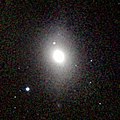Messier 85
| Messier 85 | |
|---|---|
 Galaxy Messier 85 by Hubble Space Telescope Credit: ESA/Hubble | |
| Observation data (J2000 epoch) | |
| Constellation | Coma Berenices |
| Right ascension | 12h 25m 24.0s[1] |
| Declination | +18° 11′ 28″[1] |
| Redshift | 729 ± 2 km/s[1] |
| Distance | 60 ± 4 Mly (18.5 ± 1.2 Mpc)[2] |
| Apparent magnitude (V) | 10.0[1] |
| Characteristics | |
| Type | SA(s)0+ pec[1]/E2[3] |
| Apparent size (V) | 7′.1 × 5′.5[1] |
| Other designations | |
| NGC 4382, UGC 7508, PGC 40515[1] | |
Messier 85 (also known as M85 or NGC 4382 or PGC 40515 or ISD 0135852) is a lenticular galaxy, or elliptical galaxy for other authors,[3] in the Coma Berenices constellation. It is 60 million light-years away, and it is estimated to be 125,000 light-years across.
It was discovered by Pierre Méchain in 1781. It is the northernmost outlier of the Virgo cluster discovered as of 2004[citation needed].
Properties[]
M85 is extremely poor in neutral hydrogen[4] and has a very complex outer structure with shells and ripples that are thought to have been caused by a merger with another galaxy that took place between 4 and 7 billion years ago,[4] as well as a relatively young (<3 billion years old) stellar population on its centermost region, some of it in a ring, that may have been created by a late starburst.[5]
While indirect methods imply that Messier 85 should contain a central supermassive black hole of around 100 million solar masses,[6] velocity dispersion observations imply that the galaxy may entirely lack a central massive black hole.[7]
The type I supernova, was discovered in M85 on December 20, 1960 and reached an apparent magnitude of 11.7 (its effect in the telescope-resolvable sky to outshine most red dwarves a million times closer).
This galaxy has also been the host of the first luminous red nova identified as such, M85 OT2006-1. It was discovered on January 7 of 2006 and took place on the outskirts of this galaxy.[8]
On 25th June 2020, the ATLAS telescope in Hawaii spotted a type Ia supernova 2020nlb in M85, which reached a peak magnitude of 15.7. [9] [10] [11]
M85 is interacting with the nearby spiral galaxy NGC 4394, and a small elliptical galaxy called .[12]
Gallery[]


Messier 85 properties lie somewhere between those of a lenticular and an elliptical galaxy.[13]




References[]
- ^ Jump up to: a b c d e f g "NASA/IPAC Extragalactic Database". Results for Messier 85. Retrieved 2006-11-18.
- ^ J. L. Tonry; A.Dressler; J. P. Blakeslee; E. A. Ajhar; et al. (2001). "The SBF Survey of Galaxy Distances. IV. SBF Magnitudes, Colors, and Distances". Astrophysical Journal. 546 (2): 681–693. arXiv:astro-ph/0011223. Bibcode:2001ApJ...546..681T. doi:10.1086/318301. S2CID 17628238.
- ^ Jump up to: a b Kormendy, John; Fisher, David B.; Cornell, Mark E.; Bender, Ralf (2009). "Structure and Formation of Elliptical and Spheroidal Galaxies". Astrophysical Journal Supplement. 182 (1): 216–309. arXiv:0810.1681. Bibcode:2009ApJS..182..216K. doi:10.1088/0067-0049/182/1/216. S2CID 119273143.
- ^ Jump up to: a b Hibbard, J. E.; Sansom, A. E. (2003). "A Search for H I in Five Elliptical Galaxies with Fine Structure". The Astronomical Journal. 125 (2): 667–683. arXiv:astro-ph/0211003. Bibcode:2003AJ....125..667H. doi:10.1086/345822. S2CID 14748737.
- ^ Fisher, David; Franx, Marijn; Illingworth, Garth (1996). "Line Strengths and Line-Strength Gradients in S0 Galaxies". Astrophysical Journal. 459 (1): 110. Bibcode:1996ApJ...459..110F. doi:10.1086/176873.
- ^ Kormendy, John; Bender, Ralf (2009). "Correlations between Supermassive Black Holes, Velocity Dispersions, and Mass Deficits in Elliptical Galaxies with Cores". Astrophysical Journal Letters. 691 (2): L142–L146. arXiv:0901.3778. Bibcode:2009ApJ...691L.142K. doi:10.1088/0004-637X/691/2/L142. S2CID 18919128.
- ^ Gultekin, Kayhan; Richstone, Douglas O.; et al. (2011). "Is There a Black Hole in NGC 4382?". Astrophysical Journal. 741 (1): L142–L146. arXiv:1108.1808. Bibcode:2011ApJ...741...38G. doi:10.1088/0004-637X/741/1/38. S2CID 411264.
- ^ Kulkarni, S. R.; Ofek, E. O.; Rau, A.; Cenko, S. B.; et al. (2007). "An unusually brilliant transient in the galaxy M85". Nature. 447 (7143): 458–460. arXiv:0705.3668. Bibcode:2007Natur.447..458K. doi:10.1038/nature05822. PMID 17522679. S2CID 4300285.
- ^ "AstroNote 2020-126". ATLAS20qoq (AT2020nlb): discovery of a candidate SN in MESSIER 85 (17 Mpc). Retrieved 2020-06-26.
- ^ "Messier 85". SEDS: Galaxy M85. Retrieved 2010-02-23.
- ^ "SN 2020nlb". SIMBAD. Centre de données astronomiques de Strasbourg. Retrieved 2010-02-23.
- ^ "M85, Lenticular Galaxy". Messier's Nebulae and Star Clusters. Retrieved 2009-03-29.
- ^ "The darkness within?". www.spacetelescope.org. Retrieved 4 February 2019.
External links[]
| Wikimedia Commons has media related to Messier 85. |
- Messier 85 on WikiSky: DSS2, SDSS, GALEX, IRAS, Hydrogen α, X-Ray, Astrophoto, Sky Map, Articles and images
- SEDS Lenticular Galaxy M85
- Merrifield, Michael. "M85 – Lenticular Galaxy". Deep Sky Videos. Brady Haran.
Coordinates: ![]() 12h 25m 24s, +18° 11′ 28″
12h 25m 24s, +18° 11′ 28″
- Lenticular galaxies
- Virgo Cluster
- Coma Berenices (constellation)
- Messier objects
- NGC objects
- UGC objects
- Principal Galaxies Catalogue objects
- Astronomical objects discovered in 1781







